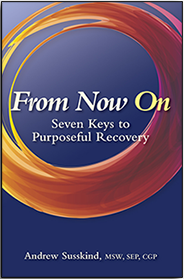We all face adversity and we all build resilience. These practices, tools and strategies give you the opportunity for nervous system regulation, resilience and overall resourcefulness. As a result, you will feel more buoyant regardless of life’s hurdles.
- Learn about the nervous system and build somatic awareness. Your resilience will be more palpable when you are feeling regulated. Become more aware of your regulated, resilient state as well as your dysregulated state. Over time, the therapeutic goal is to return more efficiently to a regulated state after being dysregulated. Pay attention to the internal differences and savor the moments when you are feeling more resilient.
- Practice mindful self-compassion on a daily basis—either in guided meditations or through positive self-talk. Check out Chris Germer or Tara Brach on YouTube for 6–8-minute, self-compassion practices. If you’re having a difficult moment during the day, take a few minutes to be kind and patient with yourself. The more you practice self-compassion, the more resilience will grow.
- Build capacity for contentment and gratitude. In order to counterbalance pain or distress, capture moments of peacefulness, calm and contentment. By practicing gratitude throughout your day you’ll begin to carve out fresh, new neural pathways resulting in a higher likelihood for resilience. Consider keeping a gratitude log—beginning and/or ending your day with a few entries.
- Find a somatically-trained psychotherapist to focus on nervous system resilience and shame resilience. Talk therapy can be helpful, but a brain-body specialist will provide you with valuable tools and healing approaches.
- Join a therapy group. Brene Brown reminds us that “shame is given to us by others and shame is healed through others.” Groups provide an opportunity to heal the deeper shame you carry and to build shame resilience instead.
- Read about the nervous system. Self-knowledge is not only empowering but it also helps your brain understand and integrate information about the healing process. Consider Bessel van der Kolk’s The Body Keeps the Score, David Grand’s Brainspotting and Peter Levine’s Waking the Tiger.
- Keep a daily resilience journal taking note of any experiences of resilience—big or small. If you want to challenge yourself, consider writing your life story focusing on all relevant formative events—including the victories and the difficulties. As you write, be sure to include the resilience you experienced after your most challenging moments.
- Identify the emotionally-reliable, loving people who you can count on through thick and thin. Your nervous system feels more resilient when you have people in your life who are dependable. Double up on your contact with these people and let them know that they are part of your resilience team.
- Consider what gives your life meaning and purpose. Positive psychologists focus on what makes life worth living or your reason to wake up in the morning. If you don’t know for sure, take a guess and start to develop some possibilities. Remember that it may be right in front of you, e.g., to be the best parent you can be.
- Cultivate a relationship with a power greater than yourself. This may be God, a Higher Power, a Universal Energy or even nature. If you are inclined to practice a spiritual connection, resilience will inevitably grow.
As always, pick and choose which of these ideas fit for you and find an accountability partner to practice them. As you pay attention to your resilience levels, notice your nervous system and its response to these strategies. Track your level of resilience with curiosity and non-judgment.




